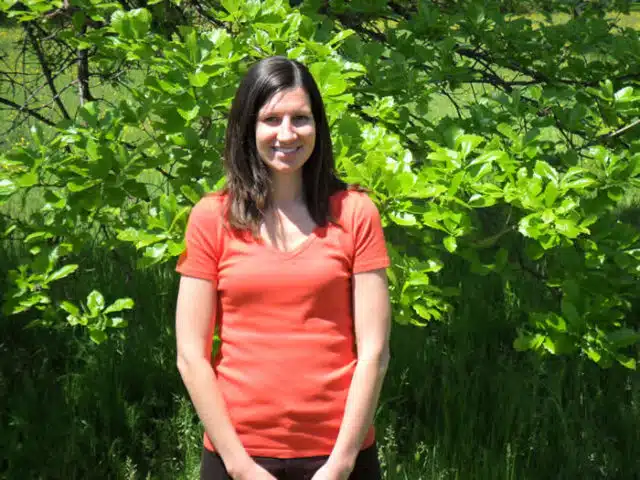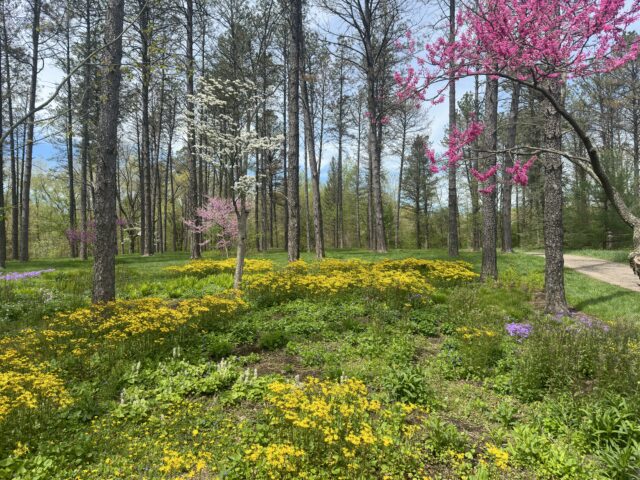
Some of the most fun stories we have in science are about surprising discoveries. Most people think of these as “eureka” moments. We can picture a scientist in a lab seeing something unexpected and shouting with excitement. “Eureka!” But, in science, these “eureka” moments don’t really exist. When we make a surprising observation, it’s not always immediately clear that what we have witnessed is, in fact, surprising at all. Today for #ScienceonFridayswithHolden, we’d like to share an observation made by our department chair, David Burke. It is a story about an unlikely pollinator and is fitting as we wrapped up #NationalPollinatorMonth earlier this week.
David has been growing herbaceous plants in the greenhouse since he started at Holden Arboretum in 2006. One of the plants that grows well for him is Jack-in-the-Pulpit (Arisaema triphyllum). We have a study that involved planting over 1300 Jack-in-the-Pulpit plants in Bole Woods. This meant growing plenty of Jack-in-the-Pulpit plants in the greenhouse and plenty of time to make observations.
After the first year that David grew Jack-in-the-Pulpit in the greenhouse, he noticed that some of the plants set seed. “I thought that was odd,” he recently told me, “Jack-in-the-Pulpit is a dioecious plant.” This means that plants have either male or female flowers, but not both, and they need a way to spread pollen from the male flowers to the female flowers in order to make seeds. In other words, they need a pollinator. Pollination is not something that we study in the Burke lab; we are root and soil ecologists. Even though our research focus is belowground, we found David’s observation aboveground interesting. What pollinator exists in our greenhouse?
Fungus gnats are a common greenhouse pest and ones that like to frequent Holden’s greenhouses. David thought maybe the fungus gnats were responsible for pollinating Jack-in-the-Pulpit and asked our greenhouse managers to stop controlling them in the spaces where he kept his plants. Each year, the Jack-in-the-Pulpit plants set seed and each year we remained curious about how the fungus gnats pollinate the plants. We recently came across a scientific paper about Japanese Jack-in-the-Pulpit (Arisaema sikokianum) and how they emit chemicals that mimic mushrooms to attract fungus gnats. (See that paper here: https://doi.org/10.1101/819136).
After coming across this paper, we researched it a bit more and found that fungus gnats have been a documented pollinator of Jack-in-the-Pulpit plants for years. Jack-in-the-Pulpit flowers emit a slight fungal odor and, since fungus gnats are mycophagous (i.e., they eat fungi), they are attracted to the flowers by this odor. Once inside the pouch-shaped, pulpit-like flower (called a spathe), the fungus gnats cannot easily escape through the top opening. If the flower is male, the trapped gnat can crawl through a small opening at the base of the spathe. But, by this time, the gnat is covered in pollen, which they can transfer to a female flower on their next journey when they are attracted to another fungal odor. We thought this was a pretty interesting pollination system because, as the scientific paper linked above states, mushroom mimicry for pollination is rare.
Jack-in-the-Pulpit pollination is not something that the Burke lab plans on studying; our “eureka” discovery is not in our area of expertise. But, we were happy to learn something new about a plant that we use a lot in our research. Maybe you learned something new too!

Sarah Kyker, PhD
Postdoctoral Research Associate
Dr. Sarah Carrino-Kyker is a microbial ecologist interested in the influence of environmental change, both natural and human-caused, on microbial communities. Because microorganisms are small in size, they are environmentally sensitive. Yet their health and functionality can have a large impact on the overall health of a habitat due to their role in ecosystem processes. Her current research is focused on the soil communities of forests, how they’re impacted by environmental changes, and how these impacts in turn affect the health of the overall habitat or ecosystem.











